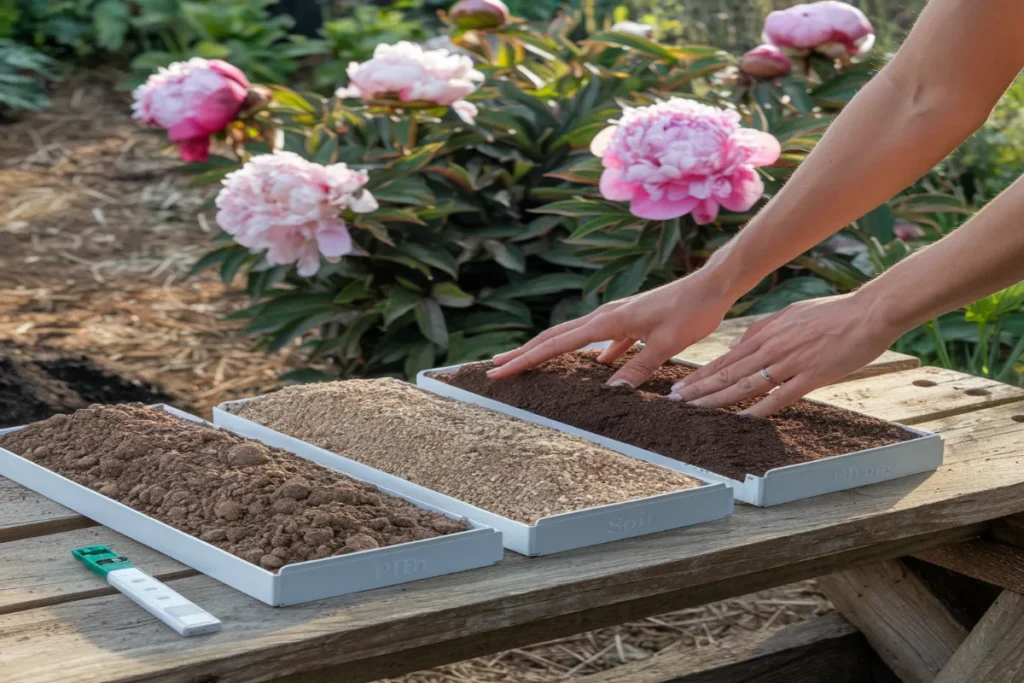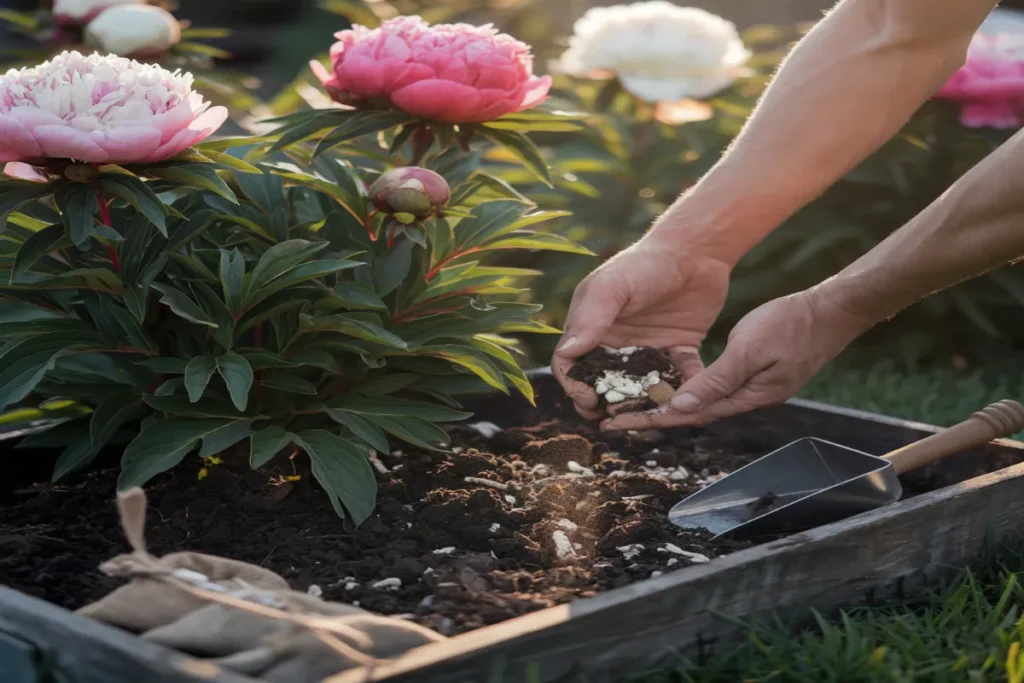My first visit to my grandmother’s garden was unforgettable. The peonies caught my eye with their vibrant blooms. It was as if they were magical. But, the secret to their beauty was hidden beneath the surface.
The soil of peony beds was the key. It was carefully cultivated. Peonies need specific soil conditions to thrive. They demand a growing environment that supports their robust root systems and spectacular blooms.
Peonies love a sandy loam soil. This balanced mixture offers nutrients and excellent drainage. The right soil can make a big difference in a peony’s growth.
Soil preparation is the first step in growing peonies. Gardeners must create an environment that supports root development. It should ensure proper nutrient absorption and provide the ideal conditions for these perennial beauties.
Every step in growing magnificent peonies is important. From choosing the planting location to nurturing the underground ecosystem, each step matters. The journey of growing magnificent peonies starts with understanding and respecting the foundation of their growth—the soil.
Table of Contents
Understanding the Importance of Soil for Peonies
Soil is key for growing peonies. The right soil can make a big difference. Peonies need specific conditions to thrive, and soil quality is very important.
Why Soil Quality Matters
The soil type affects how well peonies grow. Peonies have deep roots, so the soil must be right. Good soil means healthy plants and more blooms.
- Optimal nutrient availability
- Proper water retention
- Effective root development
- Disease resistance
Effects of Soil Composition on Growth
Soil of Peony shouldn’t be acidic. They prefer neutral to slightly alkaline soil, with a pH of 6.0 to 7.5. Different soils affect peony growth in different ways.
| Soil Type | Impact on Peonies | Recommended Action |
|---|---|---|
| Clay Soil | Poor drainage, root rot risk | Add organic matter for better drainage |
| Sandy Soil | Drains too fast, holds few nutrients | Use compost to keep nutrients |
| Loamy Soil | Best for growing | Little need for amendments |
Knowing about soil helps gardeners create the best spot for peonies. With the right soil, peonies will have strong roots, bright flowers, and stay healthy for years.
“The secret to beautiful peonies lies beneath the surface – in the soil that nurtures their roots.” – Gardening Wisdom
Ideal Soil of Peony’s Composition
To grow peonies well, you need to know what soil they like. The right soil mix is key for their growth and flowers.
Nutrient Requirements for Healthy Peonies
Peonies need a mix of nutrients to grow strong. They need:
- Nitrogen for leaves and stems
- Phosphorus for roots and flowers
- Potassium for plant strength
Be careful with nitrogen. Too much can make leaves grow but hurt the flowers. A 5-10-5 fertilizer is best for them.
pH Levels and Their Importance
Peonies like slightly alkaline soil. The best pH is between 6.5 and 7.0.
| Soil pH Level | Peony Performance |
|---|---|
| Below 6.5 | Poor nutrient absorption |
| 6.5 – 7.0 | Optimal growth and flowering |
| Above 7.0 | Excellent nutrient availability |
To make soil more alkaline, add lime or wood ash. This helps peonies grow well and bloom more.
“The secret to magnificent peonies lies in understanding their soil preferences and providing a nurturing environment.” – Gardening Expert
Types of Soil Suitable for Peonies

Choosing the right soil is key for growing peonies. Different soils affect how well these plants grow and stay healthy. Knowing about various soils helps gardeners make the best spot for their peonies.
Loamy Soil: The Ideal Growing Medium
Loamy soil is the best for peonies. It has a mix of clay, sand, and organic matter. This mix gives peonies the right slightly acidic soil pH, between 6.5 and 7.0.
- Excellent drainage properties
- Rich in nutrients
- Optimal water retention
- Supports healthy root development
Sandy Soil Considerations
Sandy soils are tricky for peonies. They warm up fast and drain well but hold onto nutrients poorly. To help, add compost and keep an eye on the soil pH.
| Sandy Soil Characteristics | Improvement Strategies |
|---|---|
| Quick drainage | Add organic matter |
| Low nutrient content | Incorporate compost |
| Rapid temperature changes | Mulch to stabilize soil temperature |
Clay Soil and Peonies
Clay soils are hard for peonies because they hold too much water. This can cause root rot. To fix this, add sand and organic matter to improve drainage and structure.
“The key to successful peony growth is understanding and improving your soil’s natural characteristics.” – Gardening Expert
By picking and preparing the right soil, gardeners can make sure their peonies grow well and bloom beautifully every year.
Best Practices for Soil Preparation
Getting the soil right is key for peonies to grow well and bloom brightly. It’s important to know what kind of soil they like. This means looking at the soil’s makeup, testing it, and how to improve it.
Starting with good soil is the first step to growing beautiful peonies. These flowers do best in soil that’s not too acidic. They love neutral to slightly alkaline soil.
Soil Testing: Your First Step to Success
Before you plant peonies, test your soil. This step is vital. It tells you what your soil is like and how to make it better.
- Collect soil samples from different spots in your garden
- Use a professional soil testing kit or get help from local agricultural services
- Check the pH levels, nutrients, and soil structure
Amending Soil for Optimal Peony Growth
After getting your soil test results, you’ll need to make changes. These changes will help your peonies grow their best.
| Soil Amendment | Purpose | Recommended Amount |
|---|---|---|
| Compost | Improve soil structure and nutrient content | 2-3 inches mixed into top 8-10 inches of soil |
| Lime | Adjust soil pH if too acidic | Based on soil test recommendations |
| Organic matter | Enhance drainage and nutrient retention | 1-2 inches worked into planting area |
Tilling and Aeration Techniques
Good soil preparation means tilling and making sure the soil breathes well. Soil of Peony need to drain well and is loose.
- Till soil to a depth of 8-10 inches
- Break up large soil clumps
- Ensure gentle slopes for water drainage
- Avoid compacting the soil during preparation
“The secret to beautiful peonies lies beneath the surface – in the quality of your soil preparation.” – Garden Experts
Soil of Peony needs to be of a pH between 6.5 and 7.0. This is neutral to slightly alkaline. By following these tips, you’ll make a great home for your peonies to thrive.
Water Drainage and Peonies
Knowing about water drainage is key for growing peonies well. The soil of peony is very important for its health. Good drainage helps the plant grow strong and keeps diseases away.
Peonies need the right amount of water. They do best in soil that drains well. This prevents water from pooling around the roots.
The Role of Drainage in Peony Cultivation
Drainage is very important for peonies:
- It stops root rot by keeping water away
- It lets oxygen into the soil
- It keeps the soil at the right temperature
- It helps the plant absorb nutrients
Identifying Drainage Challenges
It’s important to know when drainage is bad for peonies. Look out for these signs:
- Standing water after rain
- Soil that stays wet too long
- Yellow leaves or slow growth
- Fungi near the roots
“Peonies cannot tolerate wet feet, but they require consistent moisture to thrive.”
To fix drainage issues, gardeners should:
- Plant in higher spots
- Add organic matter to the soil
- Build raised beds in clay areas
- Watch how much water they get
By using the right drainage methods, gardeners can make a great home for their peonies. This leads to beautiful flowers and healthy plants every year.
Enhancing Soil Fertility
To grow peonies well, you need to know about soil fertility. It’s important to understand what kind of soil peonies like. This knowledge helps grow healthy plants with beautiful flowers.
Peonies do best in certain soil conditions. They don’t like acidic soil. Instead, they prefer soil that’s slightly neutral to slightly alkaline.
Organic Fertilizers for Peonies
Choosing the right fertilizer is key for a great peony garden. Organic fertilizers give plants the nutrients they need. They also help keep the soil healthy for a long time.
- Compost: Enriches soil structure and provides slow-release nutrients
- Bone meal: Excellent for phosphorus content, supporting root and flower development
- Aged manure: Adds organic matter and balanced nutrients
Fertilization Best Practices
Feeding your peonies right is essential for beautiful blooms. Here’s how to do it:
| Fertilization Timing | Recommended NPK Ratio | Application Rate |
|---|---|---|
| Early Spring | 5-10-10 | 1-2 cups per plant |
| Late Summer/Early Fall | 5-10-10 | 1 cup per plant |
“The secret to magnificent peonies lies in understanding their nutritional needs and providing balanced, thoughtful care.” – Gardening Expert
Don’t over-fertilize, as it can harm the roots and reduce blooms. Slow-release fertilizers are best. They give plants steady nutrients without overwhelming them.
- Monitor soil pH (6.5-7.0 is ideal)
- Use organic matter to improve soil structure
- Apply fertilizer before new growth emerges

Pro tip: Always test your soil before applying fertilizers. This ensures you’re meeting your peonies’ specific nutritional needs.
Frequently Asked Questions
What is the best soil mix for peonies?
Peonies thrive in well-draining, rich, loamy soil. The ideal mix includes:
Garden soil (loamy and well-aerated)
Compost or aged manure (for nutrients)
Perlite or sand (to improve drainage)
A bit of lime (if your soil is too acidic)
Avoid heavy clay or soggy soil—peonies hate wet feet and will rot in standing water.
Do peonies grow in Zone 8b?
Yes, but with some challenges. Peonies prefer cold winters, and Zone 8b has mild ones. To help them thrive:
Choose early-blooming varieties like ‘Festiva Maxima’ or ‘Sarah Bernhardt.’
Chill the roots before planting (store in the fridge for 6-8 weeks).
Plant in partial shade (afternoon shade helps in hot climates).
Tree peonies and Itoh hybrids tend to do better in warmer zones than traditional herbaceous peonies.
Do peonies like acidic or alkaline soil?
Peonies prefer slightly alkaline to neutral soil (pH 6.5-7.5). If your soil is too acidic, mix in lime to raise the pH. If it’s too alkaline, add sulfur or peat moss to lower it.
Where should you not plant peonies?
Avoid planting peonies in:
Full shade (they need at least 6 hours of sun for strong blooms).
Soggy, poorly drained areas (roots will rot).
Crowded spaces (they need air circulation to prevent disease).
Against walls or fences (they need airflow to avoid mildew).
They do best in open, sunny spots with well-drained soil!
What not to plant with peonies?
Peonies don’t like to be crowded, so avoid planting them near:
Large shrubs or trees (they’ll compete for nutrients and shade the peonies).
Tall aggressive perennials (like mint or bamboo).
Other plants that need constant watering (peonies like dry conditions once established).
Instead, pair them with low-growing perennials like catmint, lavender, or salvia that won’t overshadow them.
What month is best to plant peonies?
The best time to plant peonies is fall (September to November). This gives the roots time to establish before winter. If planting in spring, do it as early as possible, but expect slower growth in the first year.

